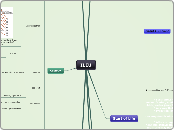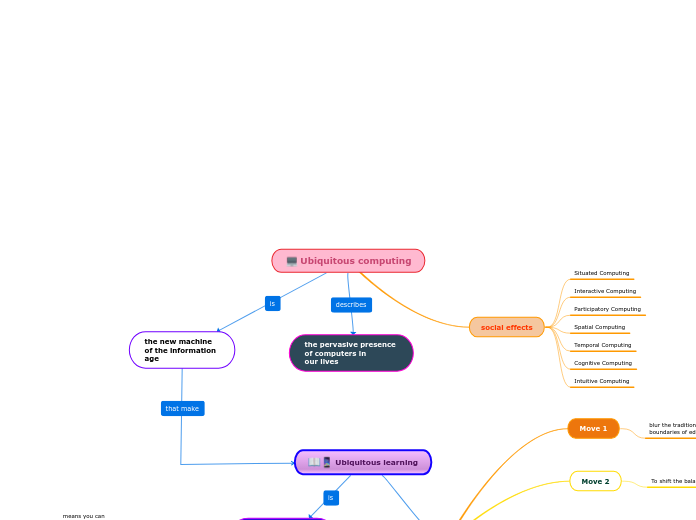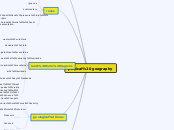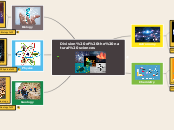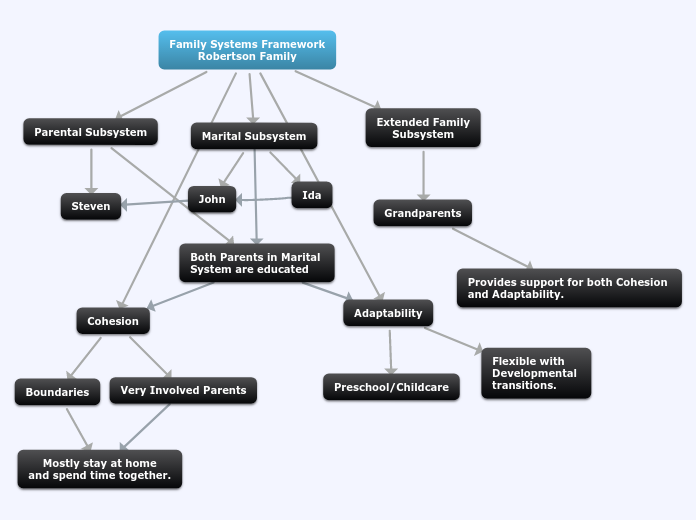Cell is basis of life (as we know)
e.g. prokaryotic cell
6 Key characteristics
Order
Reproduction
Growth & Development
Energy Utilisation
Response to Enviro
Evolutionary Adaption
Mule
cross of horse and donkey, infertile so can't carry on dna
Bacteria
unicellular
Prokaryote
any cellular organism that has no nuclear membrane, no organelles in the cytoplasm except ribosomes, and has its genetic material in the form of single continuous strands forming coils or loops
ILEU
Biology
Change Over Time
Earth's Poles
Provides information on the past behaviour of Earth's magnetic field and the past location of tectonic plates
Certain minerals in rocks lock-in a record of the direction and intensity of the magnetic field when they form.
large areas contort through buckling (bending layers)
Continents
Rifting
plates move apart
grow apart at ~9cm/year- same rate mountains grow
Divergent/Constructive Boundaries
oceanic crust (mostly Fe, Mg) is heavier than continental crust (mostly quartz), hence oceanic crust subducts and mountains form
reason for earthquakes
Divergent boundaries also form volcanic islands which occur when the plates move apart to produce gaps which molten lava rises to fill.
Shield volcanoes
Divergent boundaries within continents initially produce rifts which eventually become rift valleys.
Most active divergent plate boundaries occur between oceanic plates and exist as mid-oceanic ridges.
linear feature that exists between two tectonic plates that are moving away from each other.
Primordial Atmosphere
>95% CO2 (most removed by marine life)
Earth started with, Venus & Mars have now
Snowball/ Slushball
Geology
Stratigraphy
Sedimentary layers are laid down by deposition of sediment associated with weathering processes, decaying organic matters (biogenic) or through chemical precipitation.
Can take a long time, or might be instant - depends on what layers are made of and how they form
Same with sedimentation & tilting of layers
Biostratigraphy is based on fossil evidence in the rock layers. Strata from widespread locations containing the same fossil fauna and flora are correlatable in time.
Principle of Original Horizontality
Rock layers were initially deposited close to the horizontal
Principle of Superposition
Younger rock deposited over old
It provides strong evidence for formation (speciation) of and the extinction of species.
The geologic time scale was developed during the 19th century, based on the evidence of biologic stratigraphy and faunal succession.
This timescale remained a relative scale until the development of radiometric dating, which gave it and the stratigraphy it was based on an absolute time framework.
Lithostratigraphy, is the most obvious visible layering.
- deals with the physical contrasts in rock type.
Such layers can occur both vertically - in layering or bedding of varying rock type - and laterally - reflecting changing environments of deposition
Studies rock layers (strata) and layering (stratification)
Plate Boundaries
Transform
Where two plates are sliding horizontally past one another.
Earthquakes on surface.
Divergent
Mantle convection is the slow creeping motion of Earth's solid silicate mantle caused by convection currents carrying heat from the interior of the Earth to the surface - Leads to diverging through ridges
new crust is created as wo or more plates pull away from each other. Oceans are born and grow wider where plates diverge or pull apart.
Convergent
Crust is destroyed and recycled back into the interior of the Earth as one plate dives under another. These are known as Subduction Zones - mountains and volcanoes are often found where plates converge.
There are 3 types of convergent boundaries: Oceanic-Continental Convergence; Oceanic-Oceanic Convergence; and Continental-Continental Convergence.
Volcanoes
Can see eruptions occurred around darker/lighter surface areas (due to cooled lava)
Conical - cooler than shield, more viscous lava
Shield - hottest, liquid lava
Fossilised
Guyots
older as further away from hot spots
As the ocean floor moves over this “hot spot” at about five inches a year, the upwelling lava creates a steady succession of new volcanoes that migrate along with the plate
Huge column of upwelling lava, known as a “plume,” lies at a fixed position under the Pacific Plate.
Extraterrestrial
Comet
Two tails:
1. Plasma (indicates direction of sun)
2. Ice
Stoney (Achondrites) Meteorites - Silicate Mantle & Crust
Stoney-Iron - Small area b/w metallic outer core & SMC
Iron Meteorites - Inner & outer metallic core
stony-iron rarest b/c limited space to come from
An asteroid is always going to be in space. Once it enters an atmosphere it becomes a meteor, then a meteorite if it hits the ground
Ablation
Melting upon re/entry to atmosphere
Rocks
Chondrites
Understanding their formation is important to understand the initial development of the planetary system.
achondrites have no chondrules
Are one of the oldest solid materials within our solar system- believed to be the building blocks of the planetary system
contain chondrules- can only be formed in negligible gravity
Chondrules form as molten or partially molten droplets in space before being accreted to their parent asteroids.
Stony meteorites that have not been modified due to melting or differentiation of the parent body
Natural glass formed by melting to molten and then cooling extremely fast- unstable, w/ air pockets usually (like aero bar)
Types
Sedimentary
Tillite
Evidence of snowball Earth
part of glacial drift which was deposited directly by the glacier.
Formed by deposition of material at the Earth's surface and within bodies of water.
source of gas and oil, fracked, water
Metamorphic
Mix of sedimentary, igneous or older metamorphic
The original rock is subjected to heat (temperatures greater than 150 to 200 °C) and pressure (1500 bars)
Igneous
Formed through the cooling and solidification of magma or lava. May/ may not have crystallization
bluestone, granite
Tectonics
PROOF
- Continental fitting
- Similar fossils in diff continents
- Large amount of seismic, volcanic, and geothermal activity along the conjectured plate boundaries
- Ridges where plates are separating that are produced by lava welling up from between the plates as they pull apart. AND mountain ranges being formed where plates are pushing against each other (e.g., the Himalayas, which are still growing)
- Hot spots and consequent volcanoes moving away
- Records in magnetic minerals
Glaciation
random boulders on landscape due to: landslide, meteorites, volcano eruption
2-3 major ones in past
Horst & Graben
Formed when normal fault of opposite dip occur in pair with parallel strike lines - always formed together .
A horst represents a block pushed upward by the faulting, and a graben is a block that has dropped due to the faulting.
Regions that lie between normal faults and are either higher or lower than the area beyond the faults.
Useful Tips
Lecture 5
* two prim. processes to form elements- early universe, photons form mostly H
* cores of stars at high density and pressure
* b4 10^-43 seconds, physics breaks down- can't define where universe is
* Heisenberg uncertainty principle
* 300k years, charged becomes neutral- almost all uniform
* 3 mins= two body reactions w/ protons & neutrons 4 He
* beginning of universe
* nucleosynthesis
* isotopes of H
* energy released most favourable-as mass turns to energy E=mc^2
* anything above iron diff process- requires supernova
* cosmic ray interactions- Le,Be, B
* two processes happen in stars
* why Fe so stable (lowest binding energy per nucleon)- For an iron nucleus to undergo fission or fusion it has to absorb energy, so the odds are against it doing either of these things.
(Rather than releasing energy)
* live in atypical part of universe- too many heavy elements
* Binding energy- why Ni & Fe found in cores of planets- left over products from supernova
* stars- explode as supernova or form black hole if massive enough
* enriched clouds- gas and dust full of S and Fe b/c can't see through them
* gas cloud large enough- collapses and spins faster- hot core forms at centre- heavy elements move to center
* accretion process- growth or increase by the gradual accumulation of additional layers or matter
* solar winds from sun- clear out gas and dust left over
Lecture 6
* Sun has diff trajectory at diff times of year
* Process is ubiquitous
* Be able to explain angular momentum about planets
* Disk heats up, must cool
* Planetesimals
* Heavier elements flow towards center
* Cool enough attracts lighter elements gas
* Too hot too much kinetic energy and not attracted
* Solar wind
* Zodiacal
* Icy junk- comet
1. Left over from formation of planets like Jupiter, Saturn, tail when hot enough- see it melting
2. Finite number of times, melts a bit more each orbit
3. Two tails- one tells direction in which comet came, other is ion (plasma)- tells where sun is
* Rocky junk- asteroid- belt bw Mars & Jupiter
* Oort cloud- cold storage of comets
* Kuiper belt
* This junk helps explain how solar system formed
* Mars' moons asteroids that were captured into orbit
* Symmetric bulge of earth- bulge passes over every 12 hours, can see through high tide
* Intertidal regions huge back at formation of moon
* Why moon only faces earth one way
* What switches stars on
* 4.7 bill years ago, sun formed from supernova nearby
Solar system planets
* Watery surface crucial for life development
* Silicates in abundance
* Mercury atoms escape from surface
* Doesn't rotate in axis very much,one side typically faces sun
* Venus- primary source of atmosphere from volcanic action like Earth
* Remained same since then, Earth became diff
* 70xpressure
* Primordial atmosphere- mostly co2
* H2o evaporated, light from sun broken ,molecules into H, which then escaped, o2 bonds w/other atoms
* Mars-one mostly h2o, other icecap co2
* Jovian planets
* No solid surface
* Hard to define atmosphere
* NASA websites good about planets
* Red circle is never ending storm on Jupiter
* Rings are hundreds kms across, 20 m thick
* Not so high density, satellites passing are okay
* What elements in planets, why we see them as certain colours
* Temp measures size of velocity of molecules
* All atoms equalize to have same kinetic energy
* Hence light atoms like H have high energy, more velocity, easier to escape!
* If gravity still high at coolest part, lighter elements and molecules will stay
* No H in Earth's atmosphere
* Why does hotter planet have co2,but moon doesn't
* Why don't atoms from other processes leave?
* Plasma and dust tail
* Meteorites may evaporate on impact
* K/t bad bc of dust it'll out into atmosphere,will stay for years,ranging that depends on sunlight will stop
UNITS
Technology
Kepler Satellite
most planets are: Neptune>x> Earth
revolutionised no. of planets found
measures brightness of star periodically
Start of Life
* Fossil preservation- ice, tar pits, mummification, mud, water, bogs can pickle, amber (fossilised tree sap),
* Any way that stops decomposition
* Predation, erosion, transportation
can stop fossilisation
* After earthquake, gas on bottom rises out, asphyxiates life that flies over, it falls in and may be fossilised
* Fossils include traces, not just bones, fur, tree trunks
* Coprolites- fossilised dung
* Jellyfish preservation- falls in mud, makes hollow, have sand or something not mud on top, decomposes and leaves impression
Cntd.
* No shells to small smalls to many
* To protect environment inside from out
* Spike in O2 around 540 Ma ago
* Predator prey relationship
* Cambrian explosion- Burgess Shale- know time scale!
* Preserved sea bed
* As carbon film
* Pikaia- invertebrate, chordate- one of our ancestors
* Catastrophic event buried these things quickly (soft bodied) submarine avalanche
* Evolved to fill niche, specialisations die out if can't adapt
* Diversification
* Early life David a
Palaeozoic
* Life went to surface from ocean
* Know eons!!
* Lobe finned fish evolved legs
* No flowers in eon- ~1Ma
* Carbon iferous
Necessary/Must vs. Sufficient/ Enough to produce life
Great O2 Event
* marine life have cal carb shells, goes to bottom of ocean and turns to limestone
*
* carbon underground also maintains
* 21% o2 now
* Timeline (slides)
O2 disappears w/ oxidation
About 2300 Ma ago
Once O2 saturated, started to release into atmosphere
anoxic, disoxic, oxic
life coincides w/ O2 increase
life begins to move to land, increase in size
CO2 removed
Early life forms photosynthesised
changed dynamics of atmosphere
Stromatolites
cyanobacteria, stopped occurring ~500Ma ago
Marine life, nothing would have survived above (too much UV- Sterilise)
Formation of Solar System
formation of planets
nebula hypothesis
planetesimals form, attract one another and form planets, heavier elements fall towards center, creating core
large gas cloud collapses non-linearly, spins faster as it condenses
formed 4.6 bill years ago
initially smooth distribution of dark and baryonic
over-dense = collapse under gravity
Life of Stars
Forming stars-
* Slow collapse at first, non linear collapse
* Reaches point at which it speeds up
* Generation of stars before the solar system we now know, to have heavy elements we observe
* Gas clouds lose potential to kinetic, as it collapses it speeds up due to angular momentum
* Fusion releases energy and powers sun
* Supernova can be extremely bright
* All elements we see in everyday life from supernova
DEATH
End of Star
products of fusion - depends how massive as to what elements e.g. larger stars can continue to fuse C after He used up, or He if especially large and after C used up
outer layer blown away by solar winds, core becomes hot ember- white dwarf, black when no more energy
fusion process stops, no more fuel (H hot and dense enough to fuse)
fusion is halted since iron is so tightly bound that no energy can be extracted by fusion. Iron can fuse, but it absorbs energy in the process and the core temperature drops.
Depends on star's mass
>10 solar masses (1.99x10^30kg)
burn all H, up to Fe
final collapse and burning is fast & intense
star becomes super heavy core
remaining gas released as supernova
Core becomes:
Neutron star
Black hole (if original star heavier)
surface from 6000 to 3000K
at ~6bill yrs, star starts to change
all H in core to He, core collapses, moves further out of star, less gravity, star expands
Neutron Stars
observed as pulsars
(highly magnetized, rotating (~1 sec on axes) neutron star that emits a beam of electromagnetic radiation.)
Evolution
gas cloud collapses
Burns H in core
Later burns H in outer shells
Eventually removes outer shells as planetary nebula
forms white dwarf
Planetary Nebula: illuminated gas cluds
White Dwarf: hot ember of degenerate matter cools w/ time
classification of stars
Hertzsprung-Russell diagram (luminosity against temp)
made of H and He, and heavier element contaminants (from other supernovae)
cloud of gas collapses due to weight
causes spin to increase, dense object forms at core, heats the gas
once density & temp high enough, thermonuclear burning/ fusion starts
Jovian Planets
Uranus tilts axis at sun
Nomad/Terrestrial Planets
Venus rotates on axis opp to others
Mars
Earth
ecliptic orbit around sun
4.56 billion years old
Early formation of crust - Zircon found 4.4b yrs old
Defs
Habitable Zone
far but close enough for perfect temp
region around a star within which planetary-mass objects with sufficientatmospheric pressure can support liquid water at their surfaces
Local Supercluster
The Virgo Supercluster or Local Supercluster is the irregular supercluster that contains the Virgo Cluster in addition to the Local Group, which in turn contains the Milky Way and Andromeda galaxies.
Planets
Subtopic
Stars
large, self-luminous astronomical bodies
Galaxy
massive, gravitationally bound system consisting of stars, stellar remnants, an interstellar medium of gas and dust, and dark matter
Supercluster
cluster of galaxies forming a cluster
Cluster/group of galaxies
structure that consists of numerous galaxies bound together by gravity
